I have a data frame named 'data["df"]'. The data looks like this.
How can I get the last row in the column named 'adjclose'? The number that I want is '28.430000'.
I am trying to append this to a list. I tested this piece of code:
print(str(data.iloc[-1, data.columns.get_loc("adjclose")]) = 0))
I get this: AttributeError: 'dict' object has no attribute 'iloc'
What am I doing wrong here?
Here is my full code.
import tensorflow as tf
from tensorflow.keras.models import Sequential
from tensorflow.keras.layers import LSTM, Dense, Dropout, Bidirectional
from tensorflow.keras.callbacks import ModelCheckpoint, TensorBoard
from sklearn import preprocessing
from sklearn.model_selection import train_test_split
from sklearn.metrics import accuracy_score
from yahoo_fin import stock_info as si
from collections import deque
import numpy as np
import pandas as pd
import matplotlib.pyplot as plt
import time
import os
import random
# set seed, so we can get the same results after rerunning several times
np.random.seed(314)
tf.random.set_seed(314)
random.seed(314)
def load_data(ticker, n_steps=50, scale=True, shuffle=True, lookup_step=1,
test_size=0.2, feature_columns=['adjclose', 'volume', 'open', 'high', 'low']):
# see if ticker is already a loaded stock from yahoo finance
if isinstance(ticker, str):
# load it from yahoo_fin library
df = si.get_data(ticker)
elif isinstance(ticker, pd.DataFrame):
# already loaded, use it directly
df = ticker
# this will contain all the elements we want to return from this function
result = {}
# we will also return the original dataframe itself
result['df'] = df.copy()
# make sure that the passed feature_columns exist in the dataframe
for col in feature_columns:
assert col in df.columns, f"'{col}' does not exist in the dataframe."
if scale:
column_scaler = {}
# scale the data (prices) from 0 to 1
for column in feature_columns:
scaler = preprocessing.MinMaxScaler()
df[column] = scaler.fit_transform(np.expand_dims(df[column].values, axis=1))
column_scaler[column] = scaler
# add the MinMaxScaler instances to the result returned
result["column_scaler"] = column_scaler
# add the target column (label) by shifting by `lookup_step`
df['future'] = df['adjclose'].shift(-lookup_step)
# last `lookup_step` columns contains NaN in future column
# get them before droping NaNs
last_sequence = np.array(df[feature_columns].tail(lookup_step))
# drop NaNs
df.dropna(inplace=True)
sequence_data = []
sequences = deque(maxlen=n_steps)
for entry, target in zip(df[feature_columns].values, df['future'].values):
sequences.append(entry)
if len(sequences) == n_steps:
sequence_data.append([np.array(sequences), target])
# get the last sequence by appending the last `n_step` sequence with `lookup_step` sequence
# for instance, if n_steps=50 and lookup_step=10, last_sequence should be of 59 (that is 50+10-1) length
# this last_sequence will be used to predict in future dates that are not available in the dataset
last_sequence = list(sequences) + list(last_sequence)
# shift the last sequence by -1
last_sequence = np.array(pd.DataFrame(last_sequence).shift(-1).dropna())
# add to result
result['last_sequence'] = last_sequence
# construct the X's and y's
X, y = [], []
for seq, target in sequence_data:
X.append(seq)
y.append(target)
# convert to numpy arrays
X = np.array(X)
y = np.array(y)
# reshape X to fit the neural network
X = X.reshape((X.shape[0], X.shape[2], X.shape[1]))
# split the dataset
result["X_train"], result["X_test"], result["y_train"], result["y_test"] = train_test_split(X, y, test_size=test_size, shuffle=shuffle)
# return the result
return result
def create_model(sequence_length, units=256, cell=LSTM, n_layers=2, dropout=0.3,
loss="mean_absolute_error", optimizer="rmsprop", bidirectional=False):
model = Sequential()
for i in range(n_layers):
if i == 0:
# first layer
if bidirectional:
model.add(Bidirectional(cell(units, return_sequences=True), input_shape=(None, sequence_length)))
else:
model.add(cell(units, return_sequences=True, input_shape=(None, sequence_length)))
elif i == n_layers - 1:
# last layer
if bidirectional:
model.add(Bidirectional(cell(units, return_sequences=False)))
else:
model.add(cell(units, return_sequences=False))
else:
# hidden layers
if bidirectional:
model.add(Bidirectional(cell(units, return_sequences=True)))
else:
model.add(cell(units, return_sequences=True))
# add dropout after each layer
model.add(Dropout(dropout))
model.add(Dense(1, activation="linear"))
model.compile(loss=loss, metrics=["mean_absolute_error"], optimizer=optimizer)
return model
# Window size or the sequence length
N_STEPS = 100
# Lookup step, 1 is the next day
LOOKUP_STEP = 1
# test ratio size, 0.2 is 20%
TEST_SIZE = 0.2
# features to use
FEATURE_COLUMNS = ["adjclose", "volume", "open", "high", "low"]
# date now
date_now = time.strftime("%Y-%m-%d")
### model parameters
N_LAYERS = 3
# LSTM cell
CELL = LSTM
# 256 LSTM neurons
UNITS = 256
# 40% dropout
DROPOUT = 0.4
# whether to use bidirectional RNNs
BIDIRECTIONAL = False
### training parameters
# mean absolute error loss
# LOSS = "mae"
# huber loss
LOSS = "huber_loss"
OPTIMIZER = "adam"
BATCH_SIZE = 64
EPOCHS = 2
# save the dataframe
from datetime import date
from datetime import datetime
start_date = date(2020, 3, 1)
end_date = date(2020, 9, 18)
days = np.busday_count(start_date, end_date)
# Apple stock market
tickers = ['CHIS']
thelen = len(tickers)
z=0
all_stocks=[]
for ticker in tickers:
ticker_data_filename = os.path.join("data", f"{ticker}_{date_now}.csv")
# model name to save, making it as unique as possible based on parameters
model_name = f"{date_now}_{ticker}-{LOSS}-{OPTIMIZER}-{CELL.__name__}-seq-{N_STEPS}-step-{LOOKUP_STEP}-layers-{N_LAYERS}-units-{UNITS}"
if BIDIRECTIONAL:
model_name += "-b"
# create these folders if they does not exist
if not os.path.isdir("results"):
os.mkdir("results")
if not os.path.isdir("logs"):
os.mkdir("logs")
if not os.path.isdir("data"):
os.mkdir("data")
# load the data
data = load_data(ticker, N_STEPS, lookup_step=LOOKUP_STEP, test_size=TEST_SIZE, feature_columns=FEATURE_COLUMNS)
# save the dataframe
data["df"].to_csv(ticker_data_filename)
# construct the model
model = create_model(N_STEPS, loss=LOSS, units=UNITS, cell=CELL, n_layers=N_LAYERS,
dropout=DROPOUT, optimizer=OPTIMIZER, bidirectional=BIDIRECTIONAL)
# some tensorflow callbacks
checkpointer = ModelCheckpoint(os.path.join("results", model_name + ".h5"), save_weights_only=True, save_best_only=True, verbose=1)
tensorboard = TensorBoard(log_dir=os.path.join("logs", model_name))
history = model.fit(data["X_train"], data["y_train"],
batch_size=BATCH_SIZE,
epochs=EPOCHS,
validation_data=(data["X_test"], data["y_test"]),
callbacks=[checkpointer, tensorboard],
verbose=1)
model.save(os.path.join("results", model_name) + ".h5")
# after the model ends running...or during training, run this
# tensorboard --logdir="logs"
# http://localhost:6006/
data = load_data(ticker, N_STEPS, lookup_step=LOOKUP_STEP, test_size=TEST_SIZE,
feature_columns=FEATURE_COLUMNS, shuffle=False)
# construct the model
model = create_model(N_STEPS, loss=LOSS, units=UNITS, cell=CELL, n_layers=N_LAYERS,
dropout=DROPOUT, optimizer=OPTIMIZER, bidirectional=BIDIRECTIONAL)
model_path = os.path.join("results", model_name) + ".h5"
model.load_weights(model_path)
# evaluate the model
mse, mae = model.evaluate(data["X_test"], data["y_test"], verbose=0)
# calculate the mean absolute error (inverse scaling)
mean_absolute_error = data["column_scaler"]["adjclose"].inverse_transform([[mae]])[0][0]
#print("Mean Absolute Error:", mean_absolute_error)
def predict(model, data, classification=False):
# retrieve the last sequence from data
last_sequence = data["last_sequence"][:N_STEPS]
# retrieve the column scalers
column_scaler = data["column_scaler"]
# reshape the last sequence
last_sequence = last_sequence.reshape((last_sequence.shape[1], last_sequence.shape[0]))
# expand dimension
last_sequence = np.expand_dims(last_sequence, axis=0)
# get the prediction (scaled from 0 to 1)
prediction = model.predict(last_sequence)
# get the price (by inverting the scaling)
predicted_price = column_scaler["adjclose"].inverse_transform(prediction)[0][0]
return predicted_price
# predict the future price
future_price = predict(model, data)
print(f"Future price after {LOOKUP_STEP} days is ${future_price:.2f}")
z=z+1
print(str(z) + ' of ' + str(thelen))
# print(new_seriesdata['Adj Close'].iloc[-1])
all_stocks.append(ticker + ' act: ' + str(future_price) + ' prd: ' + str(future_price))
